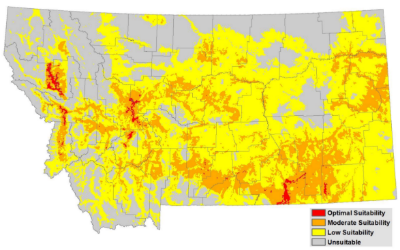Predicting the best sites to use biological control
Download weed post on Predicting the best sites to use biological control
A major hurdle in a weed biocontrol program is the introduction and establishment of viable populations of biocontrol agents. Site selection is one of the most important choices we can make at the beginning of a biocontrol program. The majority of information we have on best suited sites for successful weed management with biocontrol are based on anecdotal evidence. Most people assume that if the target weed is present, the agent can be released, but many other factors can negatively impact success. It is often difficult to identify and quantify reasons why biocontrol agents fail to establish. Factors such as soil, slope, aspect, shade or moisture could potentially all have an influence on successful establishment.
The Montana Biocontrol Project provided the Montana Natural Heritage Program with data associated with known established populations of six biocontrol agents for leafy spurge, spotted

Predicted suitable habitat for biological control (Mecinus janthiniformis) for Dalmatian toadflax.
knapweed, and yellow and Dalmatian toadflax in order to develop a predicted suitable habitat model for each. These models provide insight into site characteristics associated with successful establishment. Models help to increase the efficacy of biocontrol by guiding land managers’ releases of the insects to sites where they will most likely survive, establish, and assist in the management of the target weed species, thus saving time and money. When insects are released in suitable habitat, they are more likely to reduce the weed infestation and build up their populations to the point that they can be collected and moved to new locations, or they will disperse themselves to nearby infestations. When managed properly, established populations of biocontrol agents are a renewable resource that can be utilized for cost effective control of their target weed.
To view the complete model output for leafy spurge, spotted knapweed, and the toadflaxes, visit the following links to Montana Field Guide Species Accounts. A link to model write ups and outputs is included under the habitat section of each account.The first generation of models are preliminary and do not take into account presence of host plant species. In order to strengthen model outputs, especially in regions where we are currently lacking data, we need information on locations of known, established populations of biocontrol agents. If you know of established populations of biocontrol agents and are willing to share their locations (this location information is kept private) in order to improve model outputs, please contact Melissa at [email protected] or 406-258-4223.
Black Dot Leafy Spurge Flea Beetle – Aphthona nigriscutis
Brown-legged Leafy Spurge Flea Beetle – Aphthona lacertosa
Red-headed Leafy Spurge Stem Borer – Oberea erythrocephala
Knapweed Root Weevil - Cyphocleonus achates
Yellow Toadflax Stem-boring Weevil – Mecinus janthinus
Dalmation Toadflax Stem-boring Weevil – Mecinus janthiniformis
